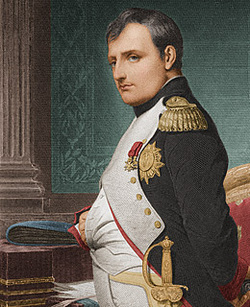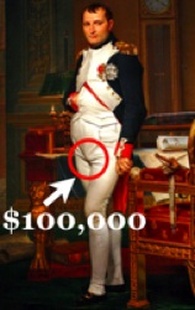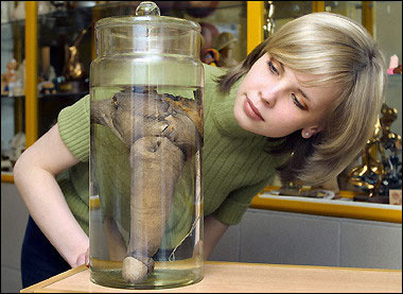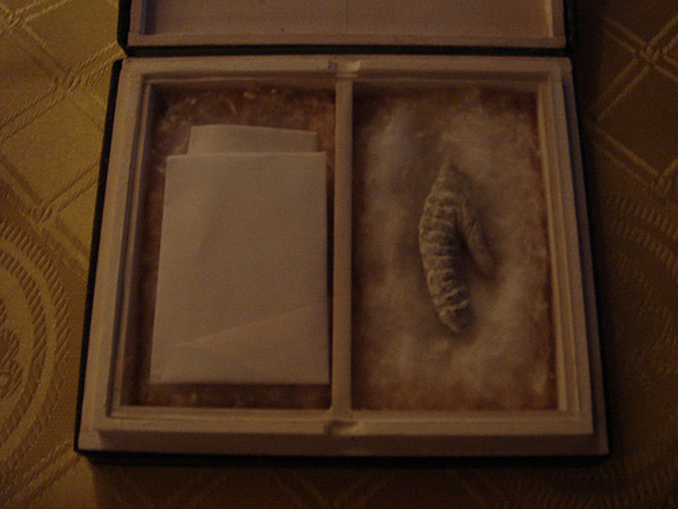Where is Napoleon's Bonaparte ?

Note that this particular topic is being posted on April Fools Day. So I decided to look at some strange but true medical history.
We can begin with Napoleon Bonaparte. He had a variety of interesting medical conditions. Part of the reason he went from being the " Little Colonel" to the Emperor of France ( they're had already been lots of kings, so being just a king didn't appeal to him) was because Napoleon was nuts. Certifiably cuckoo.
Bipolar, in modern medical terminology. Manic- Depressive in older terminology.
But being crazy and ambitious is not always a bad thing. Some people, like Napoleon , and perhaps Leonardo Da Vinci, manage to harness all that manic energy and yet still keep rational. Which leads to a creative brain on overdrive, and some entertaining achievements.
We can begin with Napoleon Bonaparte. He had a variety of interesting medical conditions. Part of the reason he went from being the " Little Colonel" to the Emperor of France ( they're had already been lots of kings, so being just a king didn't appeal to him) was because Napoleon was nuts. Certifiably cuckoo.
Bipolar, in modern medical terminology. Manic- Depressive in older terminology.
But being crazy and ambitious is not always a bad thing. Some people, like Napoleon , and perhaps Leonardo Da Vinci, manage to harness all that manic energy and yet still keep rational. Which leads to a creative brain on overdrive, and some entertaining achievements.
Penis Providence

People have been fixated on Napoleon's penis since Napoleon's doctor allegedly cut it off during his autopsy in 1821 and gave it to a priest in Corsica. The penis, which was not properly preserved, has been compared over the years to a piece of leather, a shriveled eel and to beef jerky. In 1927 when it went on display in Manhatten, Time magazine referred to it as a "maltreated strip of buckskin shoelace. "
In 1977, a urologist named John K. Latimer, living in New Jersey, purchased the modern-day relic for $3,000 and stored it under his bed for many years. Eventually it was placed in the urology museum of Columbia University, in a glass case, with the Napoleonic Crest on top. (The exhibit is not open to the public.)
Latimer's daughter inherited Napoleon's penis and has fielded at least one $100,000 offer.
Famous people having their parts snatched after death is not as unusual as you might think. Check the "Cosmetic Surgery" page for a description of what happened to John Dillinger's penis after his death.
In 1977, a urologist named John K. Latimer, living in New Jersey, purchased the modern-day relic for $3,000 and stored it under his bed for many years. Eventually it was placed in the urology museum of Columbia University, in a glass case, with the Napoleonic Crest on top. (The exhibit is not open to the public.)
Latimer's daughter inherited Napoleon's penis and has fielded at least one $100,000 offer.
Famous people having their parts snatched after death is not as unusual as you might think. Check the "Cosmetic Surgery" page for a description of what happened to John Dillinger's penis after his death.
The Little Corporal's Privates

Napoleon Bonaparte died in exile on the southern Atlantic island of Saint Helena on May 5, 1821. The following day an autopsy was conducted by the emperor's doctor, Francesco Antommarchi, in the company of 17 witnesses, including seven English doctors and two of Napoleon's aides, a priest named Vignali and a manservant, Ali.
Antommarchi removed Napoleon's heart (the deceased had requested that it be given to his estranged wife, the empress Marie-Louise, though it was never delivered) and stomach (the medical authorities present agreed that stomacn cancer was the cause of death. Although conspiracy theories say that the English poisoned him. )
Hair analysis has confirmed large amounts of arsenic in Napoleon's hair. However an arsenic compound was used to treat diarrhea in those days, and until quite recently ! And someone dying of stomach cancer might well have diarrhea. So the arsenic controversy continues.
Antommarchi removed Napoleon's heart (the deceased had requested that it be given to his estranged wife, the empress Marie-Louise, though it was never delivered) and stomach (the medical authorities present agreed that stomacn cancer was the cause of death. Although conspiracy theories say that the English poisoned him. )
Hair analysis has confirmed large amounts of arsenic in Napoleon's hair. However an arsenic compound was used to treat diarrhea in those days, and until quite recently ! And someone dying of stomach cancer might well have diarrhea. So the arsenic controversy continues.
The Peripatetic Posthumous Peregrination of Napoleons Penis

The things you see in medical museums !
Somehow the priest Vignali came into possession of the penis, and it was handed down through the family. In 1916 Vignali's descendants sold his collection of Napoleonic artifacts to a British rare book firm, which in 1924 sold the lot for about $2,000 to a Philadelphia bibliophile, A.S.W. Rosenbach.
In 1927 Rosenbach displayed the penis at the Museum of French Art in New York. tastefully couched in blue morocco and velvet.
The organ has also been described as a shriveled sea horse, a small shriveled finger, and "one inch long and resembling a grape."
In 1927 Rosenbach displayed the penis at the Museum of French Art in New York. tastefully couched in blue morocco and velvet.
The organ has also been described as a shriveled sea horse, a small shriveled finger, and "one inch long and resembling a grape."
And the real thing looks like ....

A cast of Napoleon's Penis, made when it was displayed in 1927. Photo courtesy of Time magazine.
The Vignali Collection changed hands a few more times--and eventually was put on the block at Christie's in London. It didn't sell, leading a scandal mongering British tabloid to trumpet, "NOT TONIGHT, JOSEPHINE!"
Eight years later, in 1977, the penis was put up for sale again at a Paris auction house, this time offered separately from the rest of the collection. John K. Lattimer, professor emeritus and former chairman of urology at the Columbia University College of Physicians and Surgeons, bought it for $3,000.
For those of you who are hard on the trail lof the full story, it can be found in " The Peripatetic Posthumous Peregrination of Napoleon's Penis".
Authors:Bierman, Stanley M.Source:
Journal of Sex Research; Nov92, Vol. 29 Issue 4, p579-580
Eight years later, in 1977, the penis was put up for sale again at a Paris auction house, this time offered separately from the rest of the collection. John K. Lattimer, professor emeritus and former chairman of urology at the Columbia University College of Physicians and Surgeons, bought it for $3,000.
For those of you who are hard on the trail lof the full story, it can be found in " The Peripatetic Posthumous Peregrination of Napoleon's Penis".
Authors:Bierman, Stanley M.Source:
Journal of Sex Research; Nov92, Vol. 29 Issue 4, p579-580

